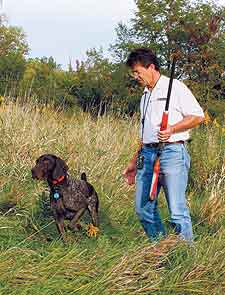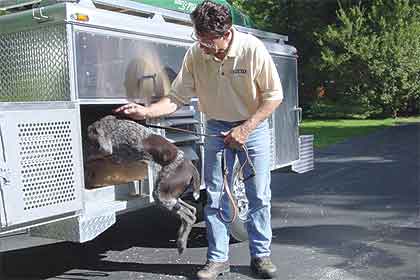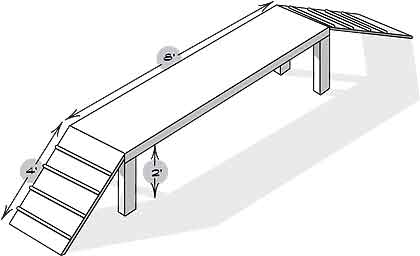These off-season projects will keep you busy -- and benefit your dog.
By Bob West
 You drilled your dog on steadiness prior to the season, but is he still reliable after two or three months in the field? If not, now's the time for a tune-up. |
This is the time of year we can begin to get a little crazy. With only a few days of bird season left, or maybe a couple snow goose hunts still ahead, we're pretty well stuck watching our friends on The Sportsman Channel or planning a spring turkey hunt.
Well, I love to hunt those big birds too, but what about our gun dogs? Remember those promises you made to yourself when training slid a little during hunting season?
Remember when old Bowser cost you the only birds you saw that morning, when he moved up and flushed the whole caboodle before you were in position to shoot? Or what about that nice rooster you knocked down and couldn't find because he broke and was unable to mark the fall?
So I'm thinking you may want to dust off some old training articles or videos and set aside some time to get things back in order, maybe to reestablish control and reinforce steadiness before the shot, or brush up on retrieving.
If you're thinking of a new pup or getting started with some serious training on an older dog you could also use this time to build a "training table."
Bottom line, there's plenty we can do this time of the year and still have a little time for television in the evenings.
Veterinarian's exam, for starters
Everyone seems to remember getting their dog's health checked and shots updated ahead of hunting season, but it's surprising how many forget a follow-up when season ends.
Think about it. Your dog has been hauled hundreds of miles, worked to extremes, hunted when he was tired and worn down, while at the same time being subjected to every kind of bug, germ, and parasite imaginable. I suggest now might be a good time for a trip to your vet.
When we do take our dog in, there are things we should be prepared to tell our veterinarian, like whether the dog's weight is off and by how much, where we've traveled, whether the dog has been sick or exposed to other dogs with problems, etc.
The more information we can provide, the more thoroughly our vet can evaluate our dog and identify any problems.
Training "Touch-ups"
We really don't have space here for details on training steps, but I'll make an educated guess regarding what your dog might need based on what I see in my own critters.
My plan for the winter months is to go back to square one and work through the basics like Heel and Come, then, once we're good there, move on to reinforcing my Whoa command and some advanced steadiness drills.
The same goes for retrieving -- back to the training table to set my foundation before beginning lining and handling drills.
The point being, we often find the seemingly complex issues go away when we back up and reestablish basic commands. After all, don't advanced expectations in handling or steadiness scenarios 'sit' on and depend on those basics as a foundation?
This is true not only in the literal understanding and obedience to those commands, but also in how we measure the benefits of our dog being in this learning, trusting, obedient and responsive mode that evolves over time through the relationship we establish by working together with our dog.
What about signing up for an obedience class? I know a lot of NAVHDA chapters sponsor classes, as do other dog clubs and local kennels. Classes are especially good if you're starting a young dog, but in all cases they're a great opportunity for socializing your dog with other dogs, places and situations.
Another benefit is meeting people with like interests, and I'm guessing you'll make new friends along with being introduced to dog clubs who will likely go out of their way to welcome you as a member.
 Teaching your dog the "Kennel" command using some sort of training table will make the transition easier to other uses of "Kennel" as a cue to load in the trailer, truck, or boat. |
Okay, let's assume you plan to take a serious look at working back into a training program after the holidays. Going along with that idea, here's a project to keep you off the couch during those long cold evenings and provide you with a very reliable tool to use while training.
Training Table
Building a training table is easy. Most of you are probably familiar with the concept but possibly haven't taken the time to build one for yourself. Now might be the time!
As you know, most trainers use some sort of platform to elevate dogs during the learning stages of commands. I begin almost all obedience work on the table.
The training table helps a lot, especially in the early stages of training when we're first trying to communicate the meanings of command sounds and associated response.
When a dog is on the ground, he's self-confident and feels in control, but you will find that getting him off the ground and onto a table takes him out of his element, causes him to be less confident and in turn makes him more attentive to us.
So the table helps establish a working relationship based on your terms, not the dog's. It helps put you in control and along with this psychological advantage, it is clearly more comfortable for the trainer because you don't have to bend over to enforce commands.
You'll find the table very useful once you have it around awhile. Aside from beginning obedience, it's also great for grooming and doctoring.
 The tra ining table is easy to build and an extremely useful tool. The design shown here is the one recommended by the North American Versatile Hunting Dog Association. |
The table is cheap and easy to build. The best design and easiest to make that I've found is the one recommended by the North American Versatile Hunting Dog Association.
All you have to do is cut an eight-foot sheet of 5„8-inch plywood lengthwise down the middle. Then cut one of those two sections in half crosswise, so you wind up with one piece that is eight feet long by two feet wide, and two pieces that are four feet long by two feet wide.
The first, larger section becomes your table's top. The other two, the 2-by-4-foot sections, serve as ramps, attached by hinges at each end of the table top.
For legs, most people use sawhorses so the table can be folded and put away when not in use. The height of the table is your preference; most find around two feet high is about right.
I often add two 8 foot lengths of 2-by-2 or 2-by-4 "stringers," one down each side on the underside of the table top, to make it stronger. I don't like the table to flex or bounce as the dog walks across it.
You can make your table as elaborate as you like, but this simple design works just fine. I'm sure that as you begin to use the training table you'll be glad you've taken the time to build it.
Final Thoughts
If you're looking for more info on training, check out the DVD Library in this magazine for such titles as Steadiness on Point: Teaching the Whoa Command; The Trained Retrieve; Electronic Collar Training and others. Also see Gun Dog's website, gundogmag.com, for many additional articles on basic and advanced training.






